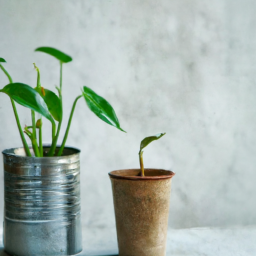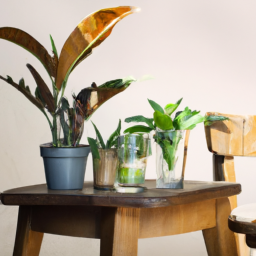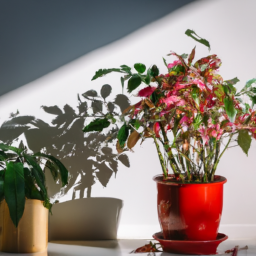
Have you ever wondered, “Can I bring indoor plants outside?” Many plant enthusiasts find themselves pondering this question, especially as the weather warms up and the sun starts shining. Whether you want to give your indoor plants a breath of fresh air or simply change up their environment, taking your plants outside can be a great way to liven up your space. But before you start moving your plants around, there are a few things to consider to ensure they thrive in their new outdoor environment. Let’s explore the ins and outs of bringing indoor plants outside and how to do it successfully.
Benefits of Bringing Indoor Plants Outside
Introduction
Bringing indoor plants outside can have numerous benefits for both the plants and the plant owner. Many people may be hesitant to move their indoor plants outdoors due to fear of damaging them, but with proper care and attention, outdoor exposure can actually be quite beneficial. In this article, we will explore the advantages of bringing indoor plants outside and provide a step-by-step guide on how to do so successfully.
Increased Sunlight Exposure
One of the primary benefits of bringing indoor plants outside is increased sunlight exposure. Most indoor plants are accustomed to low light conditions, which can limit their growth potential. By moving them outside, plants can receive direct sunlight, which is essential for photosynthesis and overall plant health. Sunlight exposure can also help indoor plants produce more vibrant flowers and foliage, making them more visually appealing.
In order to acclimate indoor plants to direct sunlight, it is important to gradually increase their exposure over a period of time. Start by placing the plants in a partially shaded area for a few hours each day, gradually increasing the amount of sunlight they receive. Be sure to monitor the plants closely for any signs of sunburn, such as yellowing or browning leaves. If sunburn occurs, move the plants to a more shaded area and gradually reintroduce them to direct sunlight.
Improved Air Circulation
Another benefit of bringing indoor plants outside is improved air circulation. Indoor environments can be stagnant, with limited air flow, which can lead to the buildup of dust, mold, and other pollutants. By moving plants outdoors, they can benefit from fresh air and natural ventilation, which can help prevent common indoor plant problems such as pests and diseases.
When bringing indoor plants outside, it is important to choose a location that has good air circulation, such as a patio or balcony. Avoid placing plants in areas that are prone to drafts or strong winds, as this can cause damage to the plants. Be sure to regularly rotate the plants to ensure even exposure to fresh air and sunlight.
In conclusion, bringing indoor plants outside can have numerous benefits, including increased sunlight exposure, improved air circulation, and overall plant health. By following the steps outlined in this article, you can successfully acclimate your indoor plants to outdoor conditions and enjoy the many advantages of outdoor gardening.

Tips for Transitioning Indoor Plants to Outdoor Environments
Understanding the Needs of Indoor Plants
Transitioning indoor plants to outdoor environments can be a great way to give them a breath of fresh air and allow them to thrive in a new environment. However, it’s important to understand that indoor plants have specific needs that differ from outdoor plants. Indoor plants are typically more sensitive to changes in temperature, light, and humidity, so it’s important to take these factors into consideration when moving them outside.
One of the key factors to consider when transitioning indoor plants to outdoor environments is the amount of sunlight they will receive. Indoor plants are used to lower light levels compared to outdoor plants, so it’s important to gradually acclimate them to the increased light levels outside. Start by placing them in a shaded area and gradually move them to a sunnier spot over the course of a few weeks to prevent sunburn.
In addition to sunlight, indoor plants also have specific temperature and humidity requirements that need to be taken into consideration when moving them outside. Most indoor plants prefer temperatures between 65-75 degrees Fahrenheit and humidity levels between 40-60%. If you live in an area with extreme temperatures or humidity levels, it’s important to monitor these factors closely and provide any necessary adjustments to ensure your plants thrive in their new environment.
Preparing Indoor Plants for the Transition
Before moving your indoor plants outside, it’s important to prepare them for the transition to help minimize shock and stress. Start by inspecting your plants for any signs of pests or diseases and treat them accordingly before moving them outside. Repotting your plants into larger containers with fresh soil can also help promote healthy growth and prevent root-bound plants.
Watering is another important factor to consider when preparing indoor plants for the transition to outdoor environments. Make sure your plants are well-hydrated before moving them outside, but be careful not to overwater as this can lead to root rot. It’s also important to adjust your watering schedule once your plants are outside, as they may require more frequent watering due to increased sunlight and temperature levels.
In addition to watering, it’s important to gradually acclimate your plants to outdoor environments to prevent shock. Start by placing them in a shaded area for a few hours each day and gradually increase their exposure to sunlight and outdoor conditions over the course of a few weeks. This will help your plants adjust to their new environment and minimize stress during the transition.
Maintaining Indoor Plants in Outdoor Environments
Once your indoor plants have been successfully transitioned to outdoor environments, it’s important to continue monitoring their growth and health to ensure they thrive in their new environment. Regularly inspect your plants for any signs of pests, diseases, or nutrient deficiencies and treat them accordingly to prevent any issues from escalating.
Proper watering and fertilizing are also key factors in maintaining indoor plants in outdoor environments. Make sure to water your plants regularly, but be mindful of overwatering as this can lead to root rot. Fertilize your plants according to their specific needs and adjust your fertilizing schedule based on their growth and development to promote healthy growth and blooming.
Lastly, it’s important to provide proper protection for your indoor plants in outdoor environments to prevent damage from pests, extreme weather conditions, and other environmental factors. Consider using natural pest control methods, providing shade during hot summer days, and bringing your plants inside during extreme weather conditions to ensure they remain healthy and thriving in their new outdoor environment.
By following these tips for transitioning indoor plants to outdoor environments and providing proper care and maintenance, you can help your plants thrive in their new environment and enjoy the beauty of nature both indoors and outdoors.

Common Mistakes to Avoid When Bringing Indoor Plants Outside
Overwatering
When bringing indoor plants outside, one common mistake that many people make is overwatering. Indoor plants are used to a controlled environment where they receive a specific amount of water on a regular schedule. When you move them outside, the conditions are different, and they may not need as much water. Overwatering can lead to root rot and other issues that can harm your plants. It’s important to monitor the moisture levels in the soil and adjust your watering schedule accordingly.
Another factor to consider is the type of container your plant is in. Some containers may not have proper drainage, which can lead to water pooling at the bottom and causing root rot. Make sure your plant’s container has drainage holes to allow excess water to escape.
Additionally, the temperature and humidity levels outside can affect how quickly the soil dries out. Be mindful of these factors and adjust your watering schedule as needed. It’s better to underwater than overwater, as most indoor plants can tolerate a little dryness better than being waterlogged.
Not Providing Adequate Sunlight
Indoor plants are accustomed to receiving filtered light through windows, which is significantly different from the direct sunlight they may receive outside. When bringing indoor plants outside, it’s essential to acclimate them to the increased light slowly. Start by placing them in a shaded area and gradually move them to a spot where they will receive the appropriate amount of sunlight for their specific needs.
On the other hand, some indoor plants may not be able to tolerate direct sunlight at all. Research the light requirements of your plants before moving them outside to ensure they will thrive in their new environment. Providing too much sunlight can lead to sunburn and damage the leaves of your plants.
It’s also important to consider the time of day when placing your plants outside. Morning sun is typically less intense than afternoon sun, so it may be beneficial to move your plants to a location where they will receive morning light and afternoon shade.
Ignoring Pests and Diseases
When bringing indoor plants outside, you are exposing them to a whole new world of pests and diseases that they may not have encountered indoors. It’s essential to inspect your plants regularly for any signs of pests, such as aphids, spider mites, or mealybugs. These insects can quickly infest your plants and cause damage if left unchecked.
In addition to pests, outdoor plants are also susceptible to diseases that may not be present indoors. Keep an eye out for any unusual spots, discoloration, or wilting on your plants, as these could be signs of a disease. If you notice any issues, it’s essential to address them promptly to prevent them from spreading to other plants.
To prevent pests and diseases from affecting your plants, you can take preventive measures such as regularly cleaning your plant’s leaves, using insecticidal soap, and quarantining new plants before introducing them to your outdoor space. By staying vigilant and proactive, you can help ensure that your plants stay healthy and thriving when brought outside.
Here are the Essential Points
Yes, you can bring indoor plants outside, but it’s important to do so with caution. Indoor plants are not used to the harsh conditions of the outdoors, so you’ll need to gradually acclimate them to their new environment. Start by placing them in a shady spot outside for a few hours each day, gradually increasing the amount of time they spend outdoors. This will help prevent shock and allow the plants to adjust to the new light, temperature, and humidity levels.
It’s also important to consider the specific needs of each plant before moving them outside. Some plants, like succulents and cacti, thrive in direct sunlight, while others, like ferns and peace lilies, prefer shade. Make sure to research the specific requirements of each plant before making the move. Additionally, be mindful of pests and diseases that outdoor plants may be exposed to, and take precautions to protect your indoor plants from potential threats. With proper care and attention, you can successfully bring your indoor plants outside and enjoy the beauty of nature in your own backyard.
Here are some FAQs you’d be interested in:
Q1. Can I bring my indoor plants outside?
A1. Yes, you can bring your indoor plants outside, but it’s important to acclimate them slowly to prevent shock from sudden changes in light, temperature, and humidity.
Q2. How should I acclimate my indoor plants to the outdoors?
A2. Start by placing your indoor plants in a shaded area outdoors for a few hours each day, gradually increasing the amount of time they spend outside over the course of a week or two. This will help them adjust to the new environment.
Q3. What should I consider before moving my indoor plants outside?
A3. Before moving your indoor plants outside, make sure to check the weather forecast to ensure there are no extreme conditions like frost or heatwaves that could harm your plants. Also, consider the specific light and water requirements of each plant to find the best spot in your outdoor space.
Q4. Can all indoor plants be moved outside?
A4. Not all indoor plants are suitable for outdoor conditions. Some plants may be sensitive to direct sunlight, strong winds, or temperature fluctuations. It’s important to research the specific needs of each plant before moving them outside.
Q5. How can I care for my indoor plants once they are outside?
A5. Once your indoor plants are outside, continue to monitor their water and light needs. Make sure to water them regularly, especially during hot and dry weather. You may also need to protect them from pests and diseases that are more common outdoors.

James Wong is a renowned ethnobotanist, plant scientist, and local television presenter. With a passion for demystifying plant science, he is known for translating complex botanical concepts into practical advice for everyday plant enthusiasts. James’s expertise spans from traditional gardening to cutting-edge plant technologies, making his insights accessible and informative.


